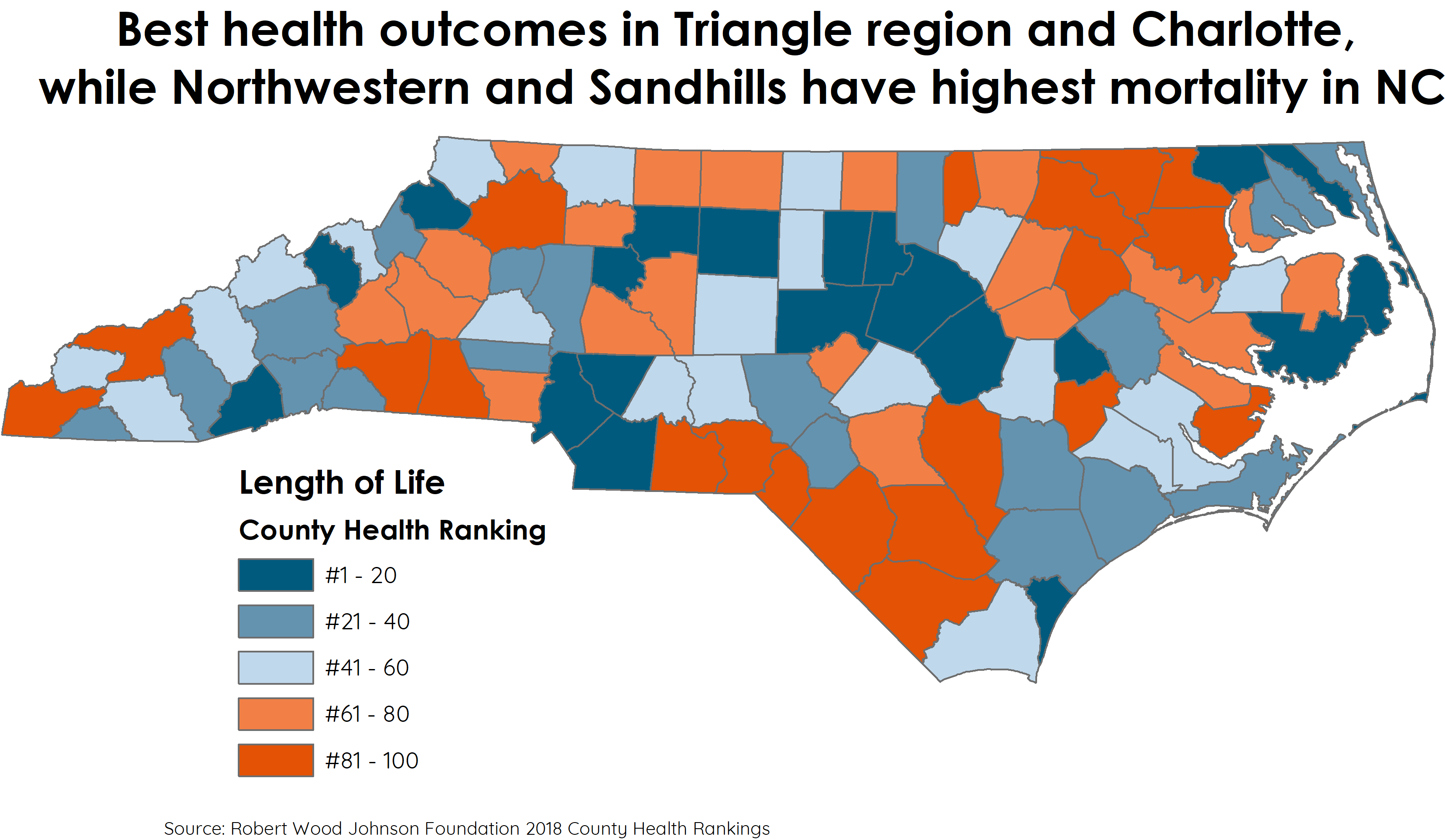NC in Focus: County Health Rankings – Length of Life in North Carolina

The Robert Wood Johnson Foundation (RWJF) releases annual health rankings at the county-level for each state in the nation. These rankings are divided into categories measuring different aspects of community wellness: Length of Life, Quality of Life, Health Behaviors, Clinical Care, and Social and Economic Factors.
Each factor is calculated by one or more markers of wellness – each deserving of a separate blog. This blog will focus on Length of Life in North Carolina counties.
How RWJF Develops the Length of Life County Health Ranking
RWJF assigns a Length of Life ranking to each county based on total “premature deaths,” defined as the total years of potential life lost before age 75 (YPLL) per 100,000 residents. Every death prior to age 75 contributes to the county’s YPLL. For example, a person who dies at age 30 contributes 45 years of life lost to a county’s total years of potential life lost. Statewide, North Carolina’s YPLL was 7,300 per 100,000, nearly on par with the national rate of 7,214.
Premature death rates provide a better indication of local risk factors in a county than measures of overall deaths, as they highlight deaths that could have been preventable. On the other hand, total mortality rates are influenced by the age structure of the region. This measure of premature death thus allows local policymakers and health officials to target higher-risk areas.
County Health Rankings
The top five counties with lowest rates of premature death are:
Of these, three fall within either the Triangle or the Charlotte metropolitan areas (followed by Mecklenburg County at #6 and Durham County at #7). This likely reflects the positive role of higher educational attainment and wide access to healthcare on health outcomes on enhancing length of life. These counties have substantially lower rates of premature death than the state and nation overall.
In fact, Orange and Wake counties fall in the 10th percentile for all US counties (up to 5,300 potential years of life lost). By comparison, the state’s overall YPLL is 7,300 potential years of life lost per 100,000 residents.
Meanwhile, the five counties with the lowest-ranking premature death rates were primarily in the Sandhills:
Across the state, counties in the northeast, Sandhills, and some Western portions of the state were among those with the worst length of life outcomes.

Racial/Ethnic Disparities in Length of Life
Length of life also differs widely across racial/ethnic demographic groups. American Indian and Black residents have much higher premature death rates than the state average and are described by RWJF as being “most similar in health to those living in the least healthy quartile of counties.”
White residents closely match the state’s overall premature death rate, while Asian and Hispanic residents are much lower than the state rate. In fact, the premature death rate for Asian and Hispanic residents is lower than even the top-ranked counties (Orange and Wake), indicating a very low overall presence of preventable death in these communities.

Next week’s series will focus on Quality of Life rankings by county. When assigning a ranking for this measure, the Robert Wood Johnson Foundation considers factors related to citizens’ overall wellbeing, including presence of illness, mental health, physical wellbeing, and infant birthweights. This comprehensive health measure allows policymakers and healthcare professionals to identify areas where citizens frequently report the worst health outcomes, and to develop targeted strategies based on the four sub-measures.
Need help understanding population change and its impacts on your community or business? Carolina Demography offers demographic research tailored to your needs.
Contact us today for a free initial consultation.
Contact UsCategories: Health & Environment, NC in Focus
Tags: counties, county health rankings, health, NC in Focus, race/ethnicity, Robert Wood Johnson Foundation, wellness

The Center for Women’s Health Research (CWHR) at the University of North Carolina School of Medicine released the 12th edition of our North Carolina Women’s Health Report Card on May 9, 2022. This document is a progress report on the…

Dr. Krista Perreira is a health economist who studies disparities in health, education, and economic well-being. In collaboration with the Urban Institute, she recently co-led a study funded by the Kate B. Reynolds Foundation to study barriers to access to…

Our material helped the NC Local News Lab Fund better understand and then prioritize their funding to better serve existing and future grant recipients in North Carolina. The North Carolina Local News Lab Fund was established in 2017 to strengthen…
Your support is critical to our mission of measuring, understanding, and predicting population change and its impact. Donate to Carolina Demography today.